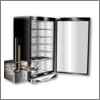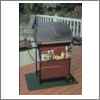
(c) Barbecue'n On The Internet
 (c) Barbecue'n On The Internet |
In looking through your response to our recent questionnaire, the one thing that strikes us as really impressive is that you, our readers, want more information on how to make better meals outdoors and less on actual recipes. Not that recipes aren't important, but it's more important you are experimenting with concepts and ideas about outdoor cooking rather than just following The Yellow Brick Road to the dinner table. You folks are really using your brains! After all, that's what we are all about, ... teaching you so you know how to do this without our help!
Anyway, let's get on with the show & get you to cooking something really great!
Let's begin by getting everyone on the same page with the more common terms and phrases associated with outdoor cooking. Besides, if you ever choose to ask Smoky a question and you use the wrong term, he will be happy to correct you with a message resembling a loving, caring and tender baseball bat.
Can you answer these questions?
Flavor, Flavor, Flavor
This is a really tough subject to cover is such a short article and, as such, will only be giving you some of the basics in helping you to balance both flavor and tenderness in your outdoor cooking. Most of these suggestions can be used on wood burning pits or gas grills using the indirect method of cooking (heat on one side and meat on the other side).
Tender, "fall off the bone", juicy, flavorful, smoky, mouth-watering, moist, great-tasting, delicious. You know the words that best fit what you are seeking to create on the 'ol backyard pit. But how do you get from here to there? Many people struggle with making their food flavorful enough to elicit comments from friends and family..."This is absolutely fantastic!"
![]()
From Our Grills To Yours

![]()

![]()
Smoky's FAQ's
Great American Barbecue & Grilling Manual
Hi {FirstName} & Welcome! We hope you enjoyed the recent article by Smoky 2 weeks ago entitled In Praise of Pork Loins. If you missed it for some reason, you can find his full article HERE. We realize you receive a TON of email each day/month and are thrilled that you want to receive the Smoke 'N Fire Enquirer each month. That only means we have to keep presenting more great tips and techniques for improving your favorite pasttime.
Getting Everyone On The Same Page
![]()
I didn't mean to say that...
To find out the answers to these and many more thoughts and ideas on the correct way to cook outdoors, (not to mention the correct terminology) please visit SMOKY'S GLOSSARY PAGE NOW! Your guests will be more than extremely grateful!
![]()
Isn't flavor what it's all about? Getting flavor INTO the tender meat is one of the chief dilemmas in the process of outdoor cooking. There are just so many variables to work with in getting not only the right flavor, but the desired flavor. Many people use marinades, tenderizers (both chemical and mechanical), rubs, injections, sprays and quite frankly it can all become more than a little confusing. Do you "mop" the meat, foil or bag the meat, use gas, electric, logs, charcoal or pellets. The variables are endless. The paradox is that you need to find out what works for you and your equipment. What we would like to do in this issue is give a little clarity in helping you know what actions can produce desired results.
Getting flavor INTO the tender meat is one of the chief dilemmas in the process of outdoor cooking. There are just so many variables to work with in getting not only the right flavor, but the desired flavor. Many people use marinades, tenderizers (both chemical and mechanical), rubs, injections, sprays and quite frankly it can all become more than a little confusing. Do you "mop" the meat, foil or bag the meat, use gas, electric, logs, charcoal or pellets. The variables are endless. The paradox is that you need to find out what works for you and your equipment. What we would like to do in this issue is give a little clarity in helping you know what actions can produce desired results.

Too Little Smoke Flavor in Your Meals? |
Too little flavor is one of the most popular complaints we receive from our readers. All types of units are being used: gas, electric, smokers, pits, grills, etc. With each type of unit, the cooking techniques must be modified. For example, there is no need to use a cast iron smoker box in a wood burning barbecue pit. Likewise, you would not use coals burned down from logs in gas grills and electric smokers. So, what to do?
Another more modern method of inducing flavor to the meal is the use of smoker pellets. Smoker pellets can be on a localized basis or it can be the entire cooking/heating source. The Traeger Wood Pellet Grill has an auger that automatically feeds hardwood pellets into the firepot. Air is added via a draft fan, which helps the pellets combust. The hot wood fire vapors surround the food and cook it. A method of introducing smoke flavor, besides using wood chips and a smoker box, is by using BBQ'rs Delight smoking pellets is the use of "aluminum foil pouches of pellets" placed directly over the heat source". Just one small hole in the aluminum foil pouch works great to provide smoke in most outdoor cookers.
One final thought on adding flavor to meals. We always enjoy using crushed garlic, rough chopped onions, bell peppers, etc., soaked in cooking oil and wrapped loosely in heavy duty foil and placed near the heat so that the oil begins to cook the items inside the foil, adding additional flavors. The flavor and aroma being added from the packet is fantastic. You may want to have have several of these flavor pouches available depending upon the length of time you are cooking. |
||
Too Much Smoke Flavor in Your Meals? |
How have people tried to overcome the strong flavors invoked by burning logs in their smoker? Aluminum Foil. Foil creates a barrier to smoke. It can't get through, period. So, rather than cooking it properly, foil is used to inhibit smoke from reaching the meat. Another issue around the use of aluminum foil is the inherent fact that confining the meat in foil is akin to cooking it in a pot. It completely changes the texture of the meat from that cooked in a dry heat to one cooked in liquid. Call it pot roast, stew or even chicken a la king. But don't call it barbecue! Others use paper bags to limit smoke contact. Why put too much smoke on the pit and then try to limit it? The right way, and the most intensive way, to produce perfectly flavored barbecue is to have a a separate "burn pit" where the wood is burned to hot coals. Then use a shovel to move the coals to the barbecue pit. This burn pit (Photo #1, Photo #2) will remove the "undesirable elements" from the wood before it is made subject to the meat. Another method to produce desired smoke flavors is to use natural or lump charcoal. This charcoal has already had the impurities that are contained in logs, burned out. This charcoal is different from charcoal briquettes and burns hotter, faster and cleaner. Additionally, charcoal briquettes have some undesirable impurities. Since natural or lump charcoal does burn hotter, you will not use as much as you might imagine. If you are using gas or electric units, you will not have as much of this problem. Should you use too much of the wood chips for too long a period of time, you too might experience too much smoke. Simply use fewer wood chips. *The desirable smoke flavor is deposited by invisible droplets, not the heavy, noxious smoke of burning wood. This deposition and the accompanying "smoke" ring are best accomplished when the temperature differential between the heat and the meat is greater. The good flavor is also deposited best upon a moist surface, so keeping the surface moist by basting or prolonging by low temperature will produce more flavor. [*Smoky Hale] These are the reasons why "good" smoke flavor is deposited in the first 2-3 hours only.
The bottom line is not to fight the system, but to learn what works and does not work in your smoker and to go with the process that works best. |
||
Too Little Seasoning Flavor |
Marinades: Once, most people used a marinade to flavor the meat that they were going to grill or barbecue. Marinades result from using oils, vinegars and spices in a liquid mixture and letting the meat marinate or soak over several hours. While marinating is still a favorite method of cooking outdoors, most serious contest cooks have abandoned the practice in favor of using dry rubs directly on the meats and basting occasionally. Dry Rubs: This method of flavoring the meat has become more mainstream because it adds seasonings directly to the meat. The seasonings are stronger than the marinades, but during the cooking process, they will "mellow" and become great flavor enhancers to the meat being cooked. On many of our meats, we will coat the meat lightly with yellow mustard which has several beneficial features. First, it holds the spices on the meat, secondly, it helps keep the meat moist while cooking and third, as it cooks and melds with the spices, it sets up a nice surface (often called "skin" or "bark"). Basting: This is a very popular method of helping to keep the meat moist when cooking over longer periods of time. You can use a basting mop to gently baste flavorful liquids on the surface of the meat every 30 to 45 minutes. We have found a basting brush to be excellent for grilling, though a little rough on the meat during longer cooking processes.
Finishing Sauce: A finishing sauce is great for adding that final touch of flavor and appearance to your finished product. Once the meat is 90% cooked or has about 20 minutes left of cooking and the temperatures are beginning to lower, then the finishing sauce can be added. The reason for waiting until the end is that most finishing sauces contain tomatoes and/or sugars which have a tendency to burn. If you want to present a "wet look" to your product, then add the finishing sauce after you have removed the meat from the pit.
|
||
| Starting With Tender Meat | This will be covered in our next issue. Stay tuned! |
||
|
This will be covered in our next issue. Stay tuned! |
||
| How long is this going to take? | This will be covered in our next issue. Stay tuned! |
The Recipe!
![]()
Kick Butt Pork Rub
This recipe is great on Boston butts, country style ribs, spare/babyback ribs and pork loins. Let's begin by collecting the following ingredients:
Mix thoroughly. Rub thoroughly into meat and allow to sit for 2 hours. Cook on pit using indirect heat (heat on one side of the grill and the meat on the other). Cook at 225° until done. Depending upon the cut of meat, generally: ribs 3-6 hours, tenderloins 3-4 hours, butts (depending upon size) 3-18 hours [cook until you can hold 180°-190° for 1 hour]. Store remainder in air tight jar and keep in freezer.
Old Smokey Contest Winner
![]()
Winner of the Old Smokey Charcoal Grill
 Each month we give away one heck of a grill to one of our lucky readers. By far, the Old Smokey Grill is our largest selling portable charcoal grill because of its durability and ability to produce great tasting food. If you would like to know more, please feel free to read about the Old Smokey Grill - #18!
Each month we give away one heck of a grill to one of our lucky readers. By far, the Old Smokey Grill is our largest selling portable charcoal grill because of its durability and ability to produce great tasting food. If you would like to know more, please feel free to read about the Old Smokey Grill - #18!
If you are receiving The Smoke 'N Fire Enquirer, you are automatically entered for this contest. There is only one winner each month! So, without further delay, the winner of this month's Old Smokey Grill - #18 is:

|
||||||
 Electric Smokers |
 Barbecue Accessories |
 Spices & Sauces |
 Thermometer & Gauges |
 Clean & Protect |
||
OUTDOOR TOYS GALORE! Check out our sale items |
||||||
Shop On-Line Now Toll Free: 888/ 789-0650 Direct: 281/ 495-1112 |
| Smoky's Corner Spices and herbs are now much more readily available and, although not quite worth their weight in gold, they are still expensive. They are absolutely indispensable for fine cooking. However, all spices are not created equal. Some are inferior in quality and may have lingered on the shelves for years. Buy the best and freshest that you can find and use them quickly or discard. [Great American Barbecue & Grilling Manual p. 222] Get more of Smoky's wisdom here. Get more of Smoky's book here. |
Grill Shopping This Year?
We had so much to cover and so little space to get it all in for you this month that we'll be sending you a Part 2 in a couple of weeks. In the meantime, get out there and get to having some fun on your grills and barbecue pits. Whatever you do, be sure to have fun doing it! If you're not having fun, go out to eat!
![]()
Get free catalogs from several great pit manufacturers
Gotta go...
If you are in the market for a shiny new grill this year, you probably should take a moment and visit our Free Catalog Pages. Here you can request a free product catalog from several manufacturers of great pits. If you are a manufacturer and would like to have your pits included in this listing, just let us know!
![]()
More information coming to you soon!
Keep Those Fires Hot!
![]()
Well, {FirstName}, we've done it again, come to the end. We hope you enjoyed
this SPECIAL EDITION of The Smoke N' Fire Inquirer. Keep on
SSSSsmokin'. . . . . Again, if you have any comments, please send
them to ..............
Charlie @ barbecue@nottingham.com
Sincerely,
Your Barbecue'n hosts,
Charlie McMurrey (a/k/a/ "PC") & And Smoky
* * * * * * * * * * * * * * * * * * * * * * * * * * * * * * * * *
All Rights Reserved © 2004
The Smoke N' Fire Enquirer
by Barbecue'n On The Internet (c)
Your Gateway to Great Barbecue'n!
http://www.barbecuen.com/
newsletter@nottingham.comThe Smoke N' Fire Enquirer
is a Copyright Publication by
Nottingham Internet Resources
14601 Bellaire, Suite 260
Houston, Texas, USA 77083
281/ 495-1112 Office
281/ 495-1123 Fax
* * * * * * * * * * * * * * * * * * * * * * * * * * * * * * * *
| Your Current Email Address: {email} Change Address Remove Address |